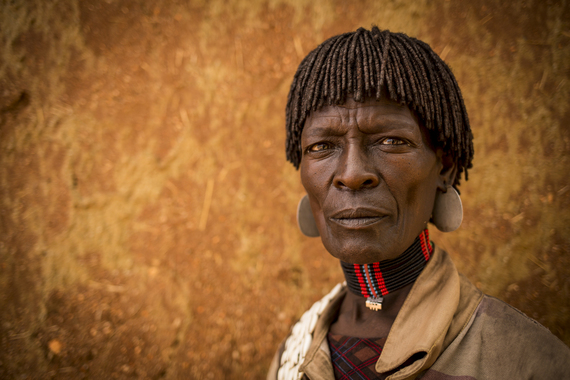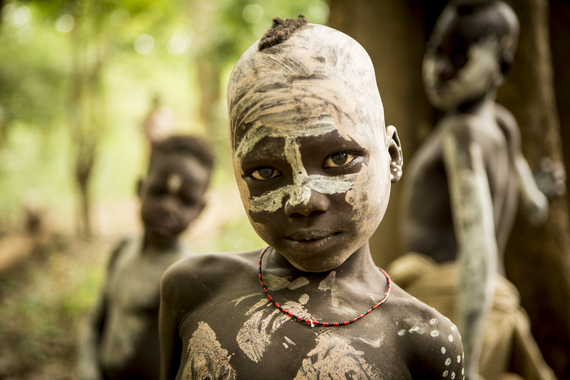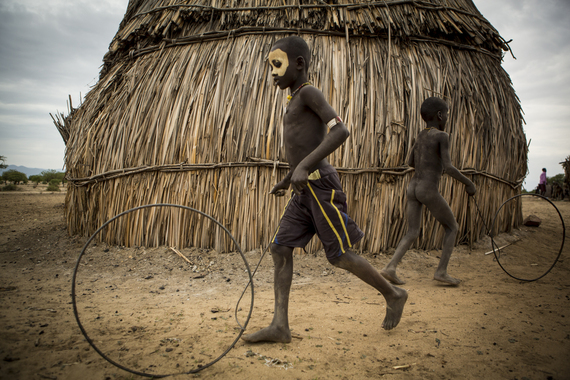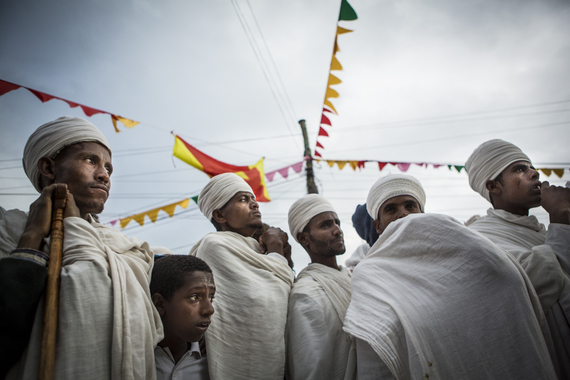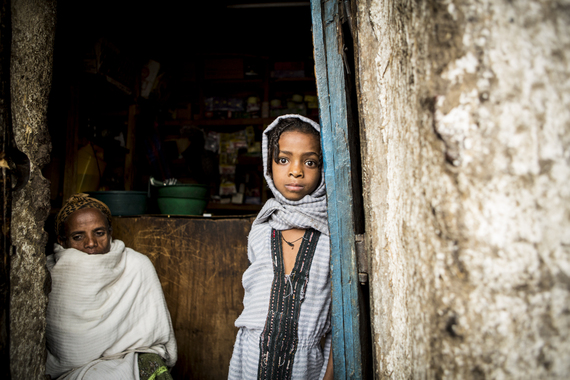An Ethiopian Journey
By Nancy Richards Farese
Our story line can change quickly, when we want it to. One day I'm in Boston at a boathouse on the Charles, learning to row, but mainly lying on the gray slats of the sauna-warm dock. My neighbors are the turtles basking similarly on the low-slung branches along the banks of the river; half in, half out. 12 hours later I'm in Frankfurt; 24 hours later I'm in Ethiopia digging deep for sketchy knowledge of Haile Selassie and the bones of Lucy. My malaria meds challenge my jet-lagged recall even more, giving me hazy dreams of Queen Sheba and swirling reggae music. I now find myself basking in the heat of the Omo Valley next to startlingly exotic lip-plated women, as curious about me as I am about them, and I feel half in, half out. Africa is familiar to me, but I've not been to this edge before.
I'm following the line of my own story by studying the intersection points with the stories of others. My tools are photography and curiosity. Rebecca Solnit writes that "empathy is first of all an act of the imagination," allowing you to leave your own narrative and step into the story of another. I talk to everyone that I can get past the initial "Where you from? Italy? Germany?" with, and Ethiopia exposes to me an intellectual vacuum of all that I don't know. It presents to me an open window that reveals both an exotic, unfamiliar scene, and a mirror into myself.
When I heard the story of the Queen of Sheba as the ancestral mother of modern Ethiopia my ignorance was confirmed. I'm not sure where I thought the Queen of Sheba came from, but I wouldn't have placed it here. Ethiopia is a story of place and a place of story, described by profoundly accepted myths, relics and data points which carve the character of everyone I meet. This is the cradle of mankind, who has been moving on 2 legs around Ethiopia for 6m years; it is the oldest continuously occupied place on our earth. "Lucy's" bones were found here in the Great Rift Valley after 3.2 m years, joined recently by fossils of her "sister" who is 3.4m years old.
The Ark of the Covenant is here, cloistered away in Axom and though only one living person is actually allowed to see the real item, its significance in local tradition and lore can not be understated. Haile Selassie's original name was Ras Tefari, which is familiar to us from his Jamaican followers who recognize him as the one true god. Ethiopia is a.k.a. "Abyssinia," historically a source of extraordinary wealth and the breadbasket of the Nile region. Ethiopia is the only country in Africa that has never been colonized, and the people are fiercely independent and mighty warriors as evidenced by many wars, most notably the trouncing the Italian Army in 1941.
The data points are not so wondrous. Haile Selassie's reign of 45 years is noted for excessive corruption and regressive economics, but the world began to pay attention when horrific pictures of skeletal famine victims leaked out beginning in the 1960s; millions died in the first of several man-made disasters of food insecurity. The subsequent Mengistu government pledged unity and recovery through communism, and brought "Red Terror," a campaign of repression, extraordinary violence and heightened tribalism. As we watch young women climbing the roads bent under the weight of 50 pounds of sticks for the daily cooking fire it is clear that Ethiopians have carried grinding poverty and political uncertainty for many centuries now.
I am here with a group of photographers traveling with National Geographic. We bounce through the Omo Valley over long distances and choppy roads, finally turning off just past a bright pink elephant-leg tree and find a village, of sticks and cows and beautiful people, in body paint and lip plates and metal bracelets and patterned scarring. They are so exotic that it seems fantastical, until we are aggressively harangued for a $.15 modeling fee for photos. Peace has introduced tourism, which has introduced capitalism, and so we pay, though the arrangement feels unnatural and bad on both sides of the lens; the moral picture doesn't match the photograph.
With locals we talk politics, history, culture. Those in our group on a constant lookout for birdlife eventually spy a drone, and we learn that the US military base is situated nearby for bomb access to Somalia. The Ethiopian government limits cell and media access to the outside world, so there is no current knowledge of Americana culture, Hollywood or many consumer goods. Their stories remain largely sealed from the outside world.
I become fixated on the lip plate and cultural ideas of beauty; what is the American equivalent? We certainly do strange and painful things in the name of personal beauty- tattoos, acid-based facials and unwanted hair removal come to mind. In Ethiopia we see scarification in elaborate swirls and graphics, whip-scarred backs from a ritual of loyalty and colorful but incredibly heavy layers of beading and metal decoration worn 24/7 that signify a woman's marital status; no room for confusion about social status here. Clearly beauty is not universally defined, and our definition is one aspect of a whole.
The photographer Chris Rainier is our guide, and an expert in indigenous and threatened cultures. He reminds us of "the conceit that we've evolved," thinking that we've written the one true story and others are somehow behind, or left out or wrong. His world view is "learning to ask the right question" as we stretch the porous edges of our own story and learn to pause, to listen, to look both out the window and in the mirror; letting go of our own narrative to become the storyteller ourselves.
